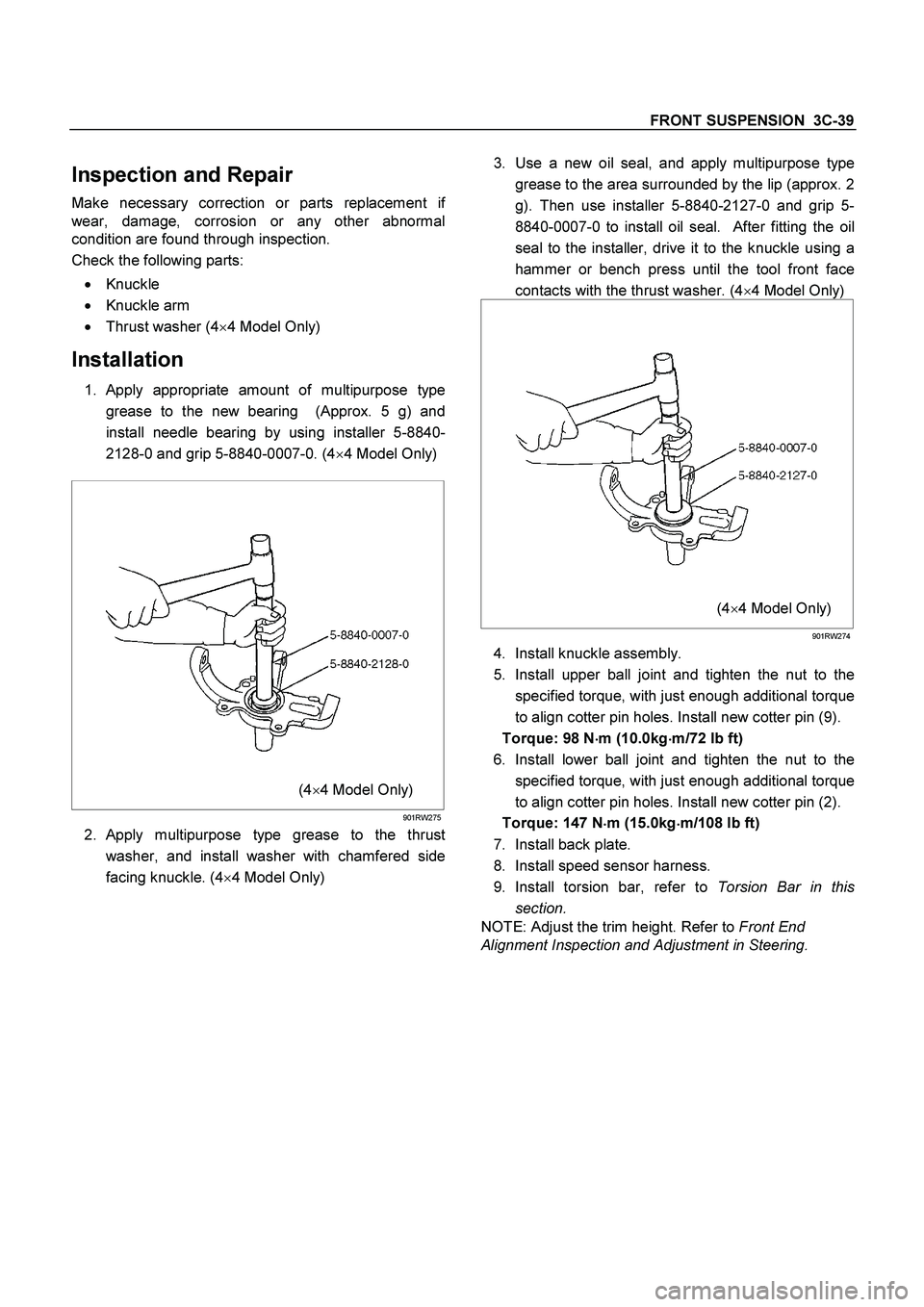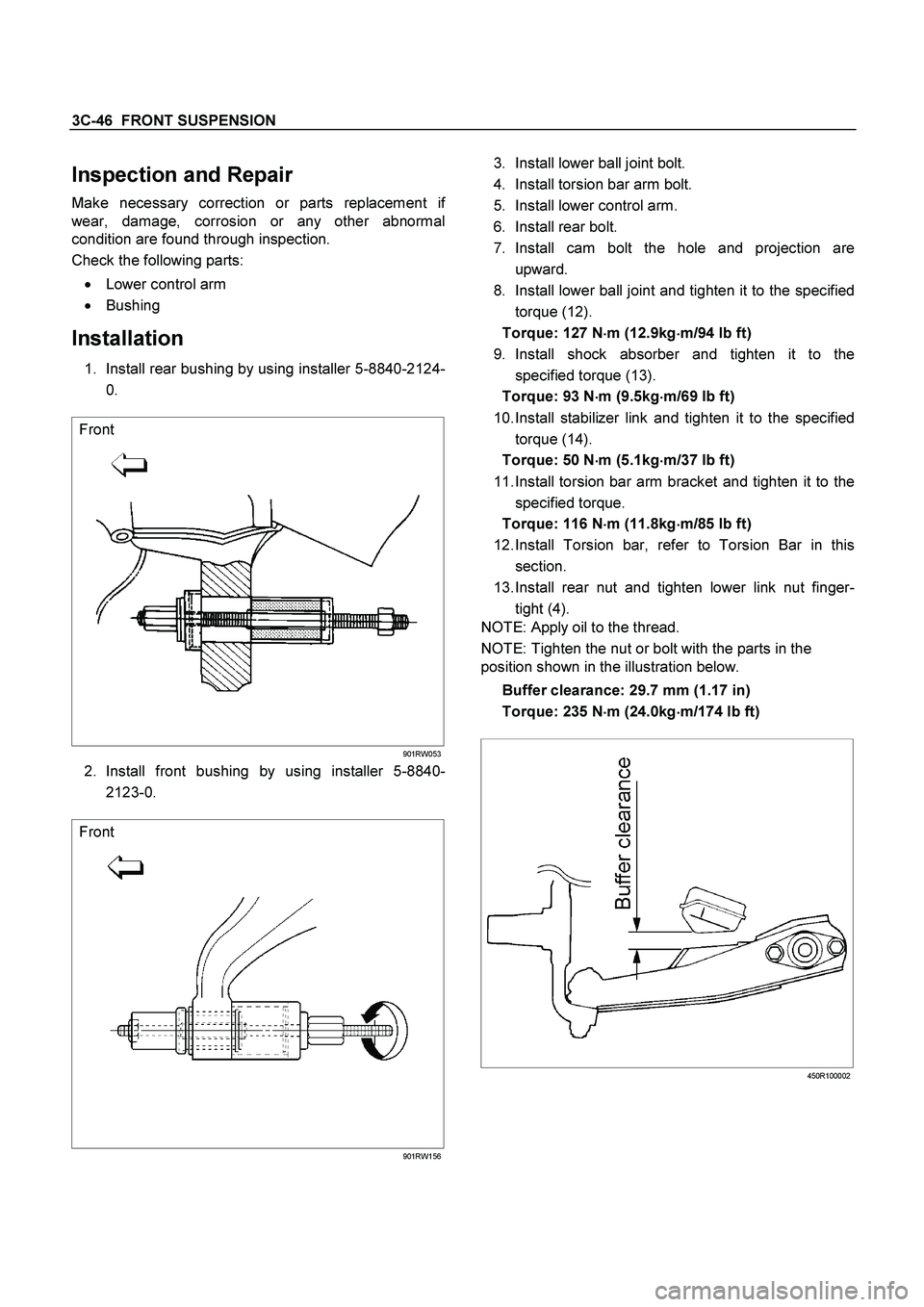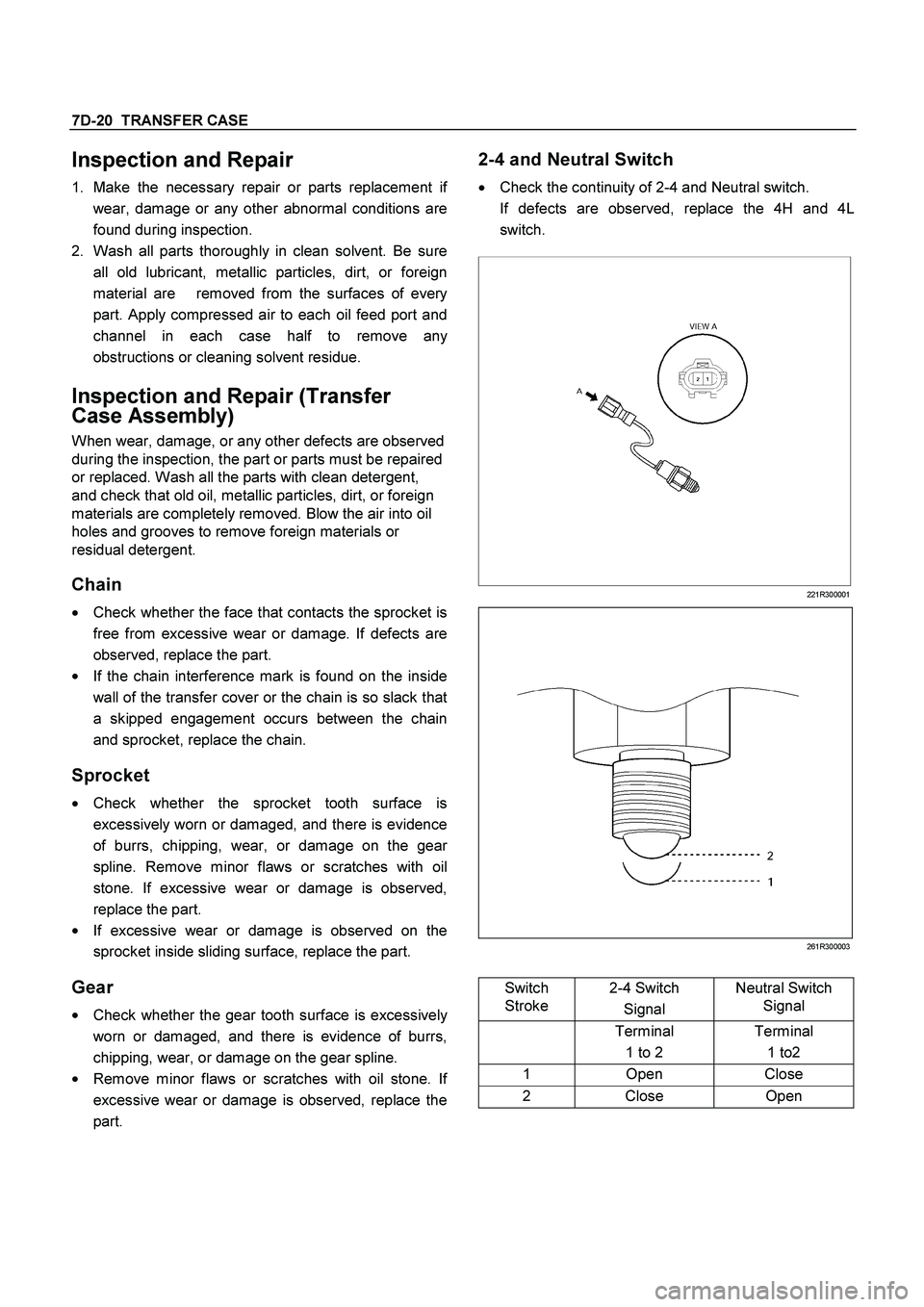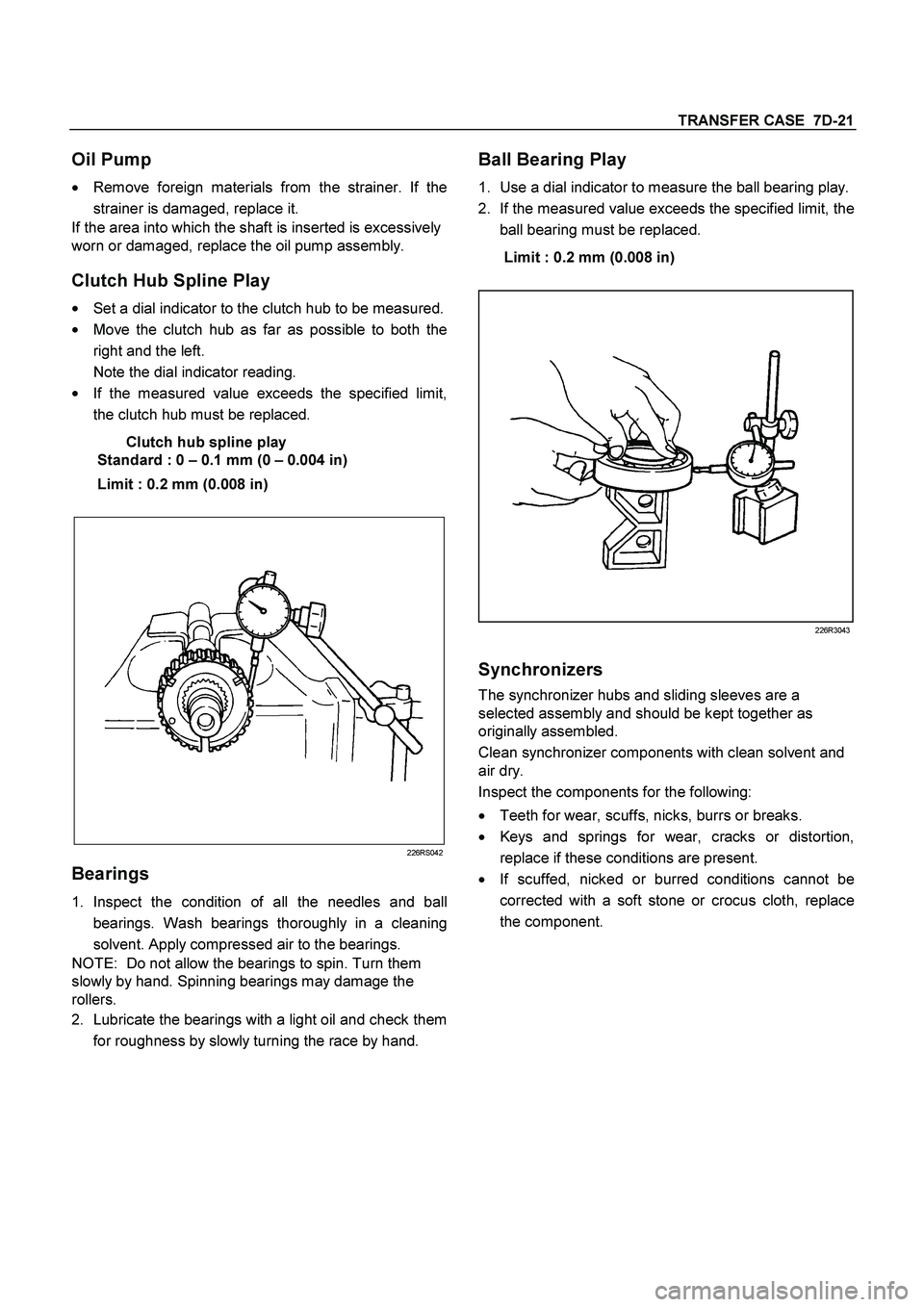Page 3531 of 4264

FRONT SUSPENSION 3C-39
Inspection and Repair
Make necessary correction or parts replacement if
wear, damage, corrosion or any other abnormal
condition are found through inspection.
Check the following parts:
�
Knuckle
�
Knuckle arm
� Thrust washer (4�4 Model Only)
Installation
1. Apply appropriate amount of multipurpose type
grease to the new bearing (Approx. 5 g) and
install needle bearing by using installer 5-8840-
2128-0 and grip 5-8840-0007-0. (4�
4 Model Only)
(4�4 Model Only)
901RW275
2. Apply multipurpose type grease to the thrust
washer, and install washer with chamfered side
facing knuckle. (4�4 Model Only)
3. Use a new oil seal, and apply multipurpose type
grease to the area surrounded by the lip (approx. 2
g). Then use installer 5-8840-2127-0 and grip 5-
8840-0007-0 to install oil seal. After fitting the oil
seal to the installer, drive it to the knuckle using a
hammer or bench press until the tool front face
contacts with the thrust washer. (4�
4 Model Only)
(4�4 Model Only)
901RW274
4. Install knuckle assembly.
5. Install upper ball joint and tighten the nut to the
specified torque, with just enough additional torque
to align cotter pin holes. Install new cotter pin (9).
Torque: 98 N�
�� �m (10.0kg�
�� �m/72 lb ft)
6. Install lower ball joint and tighten the nut to the
specified torque, with just enough additional torque
to align cotter pin holes. Install new cotter pin (2).
Torque: 147 N
�
�� �m (15.0kg
�
�� �m/108 lb ft)
7. Install back plate.
8. Install speed sensor harness.
9. Install torsion bar, refer to Torsion Bar in this
section.
NOTE: Adjust the trim height. Refer to Front End
Alignment Inspection and Adjustment in Steering.
Page 3538 of 4264

3C-46 FRONT SUSPENSION
Inspection and Repair
Make necessary correction or parts replacement if
wear, damage, corrosion or any other abnormal
condition are found through inspection.
Check the following parts:
�
Lower control arm
�
Bushing
Installation
1. Install rear bushing by using installer 5-8840-2124-
0.
Front
901RW053
2. Install front bushing by using installer 5-8840-
2123-0.
Front
901RW156
3. Install lower ball joint bolt.
4. Install torsion bar arm bolt.
5. Install lower control arm.
6. Install rear bolt.
7. Install cam bolt the hole and projection are
upward.
8. Install lower ball joint and tighten it to the specified
torque (12).
Torque: 127 N�
�� �m (12.9kg�
�� �m/94 lb ft)
9. Install shock absorber and tighten it to the
specified torque (13).
Torque: 93 N�
�� �m (9.5kg�
�� �m/69 lb ft)
10. Install stabilizer link and tighten it to the specified
torque (14).
Torque: 50 N�
�� �m (5.1kg�
�� �m/37 lb ft)
11. Install torsion bar arm bracket and tighten it to the
specified torque.
Torque: 116 N
�
�� �m (11.8kg
�
�� �m/85 lb ft)
12. Install Torsion bar, refer to Torsion Bar in this
section.
13. Install rear nut and tighten lower link nut finger-
tight (4).
NOTE: Apply oil to the thread.
NOTE: Tighten the nut or bolt with the parts in the
position shown in the illustration below.
Buffer clearance: 29.7 mm (1.17 in)
Torque: 235 N�
�� �m (24.0kg�
�� �m/174 lb ft)
450R100002
Page 3547 of 4264
FRONT SUSPENSION 3C-55
2. VEHICLE PULLS TO RIGHT OR LEFT
Checkpoint Trouble Cause Countermeasure
Steering linkage, and upper
and lower link
Rubber bushing for upper and
lower link
Wheel alignment
Vehicle trim height
Replace
Replace
Adjust
Adjust
Deformed
Worn
Incorrect
Incorrect
Brake adjustment (binding)
Adjust
Replace
Incorrect
Collapsed or break (4�
2
Except high ride suspension)
Collapsed or twisted (4�
4, 4�
2
High ride suspension)
Continued on the next pageOK OK OK OK
NG NG NG NG NG NG
OK OK Coil spring (4�2 Except high
ride suspension)
Torsion bar (4�
4, 4�
2 High
ride suspension)
Front wheel bearing
Adjust or replace
Incorrect adjustment or
abrasion
NG
Page 3551 of 4264
FRONT SUSPENSION 3C-59
5. NOISES
Checkpoint Trouble Cause Countermeasure
Lubricating oil and grease for
upper and lower ball joint
Shock absorber
Stabilizer fixing nuts and bolts
Upper and lower links
bushings
Replace
Replace
Retighten
Replace
Insufficient
Faulty
Loose
Worn
Shock absorber fixing nut and
bolt
Retighten
Loose
Continued on the next pageOK OK OK OK
NG NG NG NG NG
OK
Upper and lower ball joint
Replace
Damaged
NG
Page 3552 of 4264
3C-60 FRONT SUSPENSION
Checkpoint Trouble Cause Countermeasure
Steering linkage and steering
gearReplaceWorn
AdjustImproper OK
NG NG
OKTire pressure Continued from the previous page
Steering unit fixing bolts and
linkageRetightenLoose
Adjust or replaceIncorrect adjustment or
abrasion OK
NG NG
OKFront wheel bearing
Lubricating oil and grease to
steering linkageReplaceInsufficient NG OK
Page 3570 of 4264
3D-14 REAR SUSPENSION
3. SPRING BREAKAGE
Checkpoint Trouble Cause Countermeasure
Replace
Oil leakage
NG
Shock absorber
Replace
Bushing worn
U-bolts
Shackle pins and pivot pins
Replace
Retighten
Retighten
Damaged
Bolts and nuts for loosening
Bolts and nuts for loosening
Replace
Worn or damaged
OK
OK
NG
NG
NG
NG
NG
OK
Condition of loading
Continued on the next page
Page 3608 of 4264

7D-20 TRANSFER CASE
Inspection and Repair
1.
Make the necessary repair or parts replacement if
wear, damage or any other abnormal conditions are
found during inspection.
2.
Wash all parts thoroughly in clean solvent. Be sure
all old lubricant, metallic particles, dirt, or foreign
material are removed from the surfaces of every
part. Apply compressed air to each oil feed port and
channel in each case half to remove any
obstructions or cleaning solvent residue.
Inspection and Repair (Transfer
Case Assembly)
When wear, damage, or any other defects are observed
during the inspection, the part or parts must be repaired
or replaced. Wash all the parts with clean detergent,
and check that old oil, metallic particles, dirt, or foreign
materials are completely removed. Blow the air into oil
holes and grooves to remove foreign materials or
residual detergent.
Chain
�
Check whether the face that contacts the sprocket is
free from excessive wear or damage. If defects are
observed, replace the part.
�
If the chain interference mark is found on the inside
wall of the transfer cover or the chain is so slack that
a skipped engagement occurs between the chain
and sprocket, replace the chain.
Sprocket
�
Check whether the sprocket tooth surface is
excessively worn or damaged, and there is evidence
of burrs, chipping, wear, or damage on the gear
spline. Remove minor flaws or scratches with oil
stone. If excessive wear or damage is observed,
replace the part.
�
If excessive wear or damage is observed on the
sprocket inside sliding surface, replace the part.
Gear
�
Check whether the gear tooth surface is excessively
worn or damaged, and there is evidence of burrs,
chipping, wear, or damage on the gear spline.
�
Remove minor flaws or scratches with oil stone. I
f
excessive wear or damage is observed, replace the
part.
2-4 and Neutral Switch
�
Check the continuity of 2-4 and Neutral switch.
If defects are observed, replace the 4H and 4L
switch.
221R300001
261R300003
Switch
Stroke 2-4 Switch
Signal Neutral Switch
Signal
Terminal
1 to 2 Terminal
1 to2
1 Open Close
2 Close Open
Page 3609 of 4264

TRANSFER CASE 7D-21
Oil Pump
�
Remove foreign materials from the strainer. If the
strainer is damaged, replace it.
If the area into which the shaft is inserted is excessively
worn or damaged, replace the oil pump assembly.
Clutch Hub Spline Play
�
Set a dial indicator to the clutch hub to be measured.
�
Move the clutch hub as far as possible to both the
right and the left.
Note the dial indicator reading.
�
If the measured value exceeds the specified limit,
the clutch hub must be replaced.
Clutch hub spline play
Standard : 0 – 0.1 mm (0 – 0.004 in)
Limit : 0.2 mm (0.008 in)
226RS042
Bearings
1.
Inspect the condition of all the needles and ball
bearings. Wash bearings thoroughly in a cleaning
solvent. Apply compressed air to the bearings.
NOTE: Do not allow the bearings to spin. Turn them
slowly by hand. Spinning bearings may damage the
rollers.
2.
Lubricate the bearings with a light oil and check them
for roughness by slowly turning the race by hand.
Ball Bearing Play
1.
Use a dial indicator to measure the ball bearing play.
2.
If the measured value exceeds the specified limit, the
ball bearing must be replaced.
Limit : 0.2 mm (0.008 in)
226R3043
Synchronizers
The synchronizer hubs and sliding sleeves are a
selected assembly and should be kept together as
originally assembled.
Clean synchronizer components with clean solvent and
air dry.
Inspect the components for the following:
�
Teeth for wear, scuffs, nicks, burrs or breaks.
�
Keys and springs for wear, cracks or distortion,
replace if these conditions are present.
�
If scuffed, nicked or burred conditions cannot be
corrected with a soft stone or crocus cloth, replace
the component.